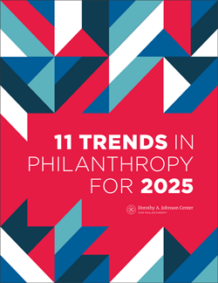With Unique Approaches and Millions Raised, Giving Days Grow Up


 This article was first published in our 11 Trends in Philanthropy for 2025 report. Explore the full report here.
This article was first published in our 11 Trends in Philanthropy for 2025 report. Explore the full report here.
Want the latest trends, research, and more delivered right to your inbox? Subscribe to the Johnson Center email newsletter.
GivingTuesday (2024a) was launched in 2012 as a way to encourage generosity during the holiday season. The hashtag #GivingTuesday made it fun and modern in the early 2010s, and it quickly became a viral fundraising phenomenon. The GivingTuesday Data Commons (2023) estimates that GivingTuesday has raised $13 billion since its first year.
But with so many nonprofits and community groups trying to capture attention on the same day, too many of those messages got lost in the noise. What came next was likely predictable — and is well summarized by The Nonprofit Times headline (2017): “Giving Days Get Cluttered so Charities Start Their Own.”
New organization- and cause-specific giving days are popping up throughout the year and raising significant dollars. Even GivingTuesday (n.d.) now has an initiative called #GivingEveryTuesday. The success of these giving days has significant implications for the giving cycle, strategic planning, donor engagement, and more.
The success and growth of giving days (typically 24-hour events combining online and in-person opportunities to give, promote, and engage) can be attributed to the ease of online giving, the social media presence of nonprofits (Bhati & McDonnell, 2020), and the sense of community that giving days offer (Bhati & Burk, 2023). The shift toward online giving has been especially crucial in fueling their success; especially for small organizations with revenue under $1 million, the percentage of gifts donated online increased more than organizations of other sizes in 2023, with nearly 17% of donations coming from online sources (Blackbaud, 2024).
Giving days have also proven to be a successful strategy for quickly converting prospects into first-time donors: EAB, a best practices firm serving education institutions, reported that the average share of alumni of private colleges and universities who make their first gift on a giving day was 12.7%; 19.8% for alumni of public institutions (Jones, 2024). Fundraising teams can also tap donor renewals and reengage lapsed donors by playing on the condensed timeline and the energy of the day — using hourly prizes, matching gifts, real-time dashboards, and more to grab attention and cultivate donations (Smilde & Ayrea, 2022). The concept is inherently flexible and scalable — making room for every organization to take its own approach.
The strategy to schedule GivingTuesday for the first Tuesday following Thanksgiving was no accident: leaders at the 92nd Street Y and the United Nations Foundation chose the day following Black Friday, Small Business Saturday, and Cyber Monday in order to take advantage of the public’s already heightened attention for themed spending days (Piper, 2023). They used that attention to create a philanthropic phenomenon.
Now, organizations and causes are taking that same approach, but in alignment with their own unique missions and audiences:
The Michael J. Fox Foundation for Parkinson’s Research aligned its 2024 Day of Giving with World Parkinson’s Day in April. According to its website, “by coming together on one day, everyone can amplify their impact and bring us one step closer to a world without Parkinson’s” (para. 2).
Colleges and universities are converting often otherwise random days of the year into full-blown giving bonanzas, using a one-day deadline to create tremendous drive:
Purdue University held its first giving day in 2013. In its first five giving days, 44% of donors were first-time supporters of the university (Joslyn, 2018). The Purdue Day of Giving continues to be successful, raising over $76 million on April 24, 2024.
Community foundations, too, are taking up the strategy. Knowing that location matters — a GivingPulse (2024) survey showed that 65% of individuals gave locally — community foundations are also increasingly using giving days as a place-based, collaborative way to expand giving for nonprofits in their communities. Bhati and Burk (2023) found only two giving days led by community foundations in 2009, but 71 giving days in 2022. According to their analysis, the amount raised by community foundation-led giving days grew from an inflation-adjusted $6 million in 2009 to $282 million in 2022. Examples include:
Since 2009, over 3,000 nonprofits have participated in the Communities Foundation of Texas’ North Texas Giving Day. In 2024, the 16th annual event raised over $68 million. According to its website, North Texas Giving Day is the largest community-wide giving event in the nation. One participating nonprofit in the region, North Texas Food Bank (2024), raised almost $1.4 million.
Across the sector, giving days are making an impact — not only on the outcomes of our work but on the work itself. The annual giving cycle, for instance, has long been tied to a major boom at the end of the year. According to Nonprofits Source (2024), 30% of annual giving from individuals occurs in December. While that statistic may not change significantly for the sector as a whole, giving days may cause dramatic shifts for individual organizations. Endicott College in Massachusetts, for example, raised $623,700 on their giving day in March 2024 (Sweeney, 2024, para. 3) — just over half (53%) of the their total annual fund contributions for the previous year ($1,188,787) (Endicott College, 2024).
Smilde and Ayrea (2022) also emphasize the true extent of the planning, brand integration, data, and gift processing that needs to go into a successful giving day — elements that may take months, if not the entire year to put in motion and execute. To activate their leadership, communications and marketing functions, events, gift processing, and others as part of a specific and coordinated initiative, organizations need to take a proactive and strategic approach, rather than allowing individual functions to react to giving cycles on their own.
Additionally, while online giving’s overall trajectory has been fairly flat — Blackbaud (2014, 2024) calculated online giving at 6.4% of total giving in 2013 and only 8% by 2022 — the rise of GivingTuesday and so many individual giving days that count on social media and online donations to be successful may help push online giving to finally make up real ground as a proportion of overall giving.
Ultimately, the giving days we’re seeing now are in many ways an evolution of long-familiar fundraising events — telethons, public media pledge drives — that have been standard and successful practice for decades. Yet given the amount of investment, media connections, and organizational capacities required to pull off a telethon in 1990, for example, these special giving events were often the exclusive purview of major charities and well-known causes. What GivingTuesday and the internet have achieved is the democratization of the giving day. Organizations and causes of all sizes can now take advantage of the model and scale to their capacities — and they’re doing just that.


American Red Cross. (n.d.) What is Giving Day? https://www.redcross.org/donations/ways-to-donate/giving-day.html
Bhati, A., & Burk, A. (2023). The landscape of community-based giving days in the United States. The Foundation Review, 15(4). https://doi.org/10.9707/1944-5660.1674
Bhati, A., & McDonnell, D. (2020). Success in an online giving day: The role of social media in fundraising. Nonprofit and Voluntary Sector Quarterly, 49(1), 74-92. https://doi.org/10.1177/0899764019868849
Blackbaud. (2014, February). Charitable giving report. How nonprofit fundraising performed in 2013. https://webfiles-sc1.blackbaud.com/files/resources/downloads/2014/2013.charitablegivingreport.pdf
Blackbaud. (2024, April 8). Blackbaud Institute shares spotlight on 2023 trends in giving. https://www.blackbaud.com/newsroom/article/blackbaud-institute-shares-spotlight-on-2023-trends-in-giving
Communities Foundation of Texas. (n.d.) North Texas Giving Day. https://cftexas.org/north-texas-giving-day/
GivingTuesday. (n.d.) Giving every Tuesday. https://www.givingtuesday.org/givingeverytuesday/
GivingTuesday. (2023, November 29). $3.1 billion in giving & millions united around generosity to celebrate GivingTuesday 2023. https://www.givingtuesday.org/blog/3-1-billion-in-giving-millions-united-around-generosity-to-celebrate-givingtuesday-2023/
GivingTuesday. (2024a). About. https://www.givingtuesday.org/about/
GivingPulse. (2024, January to March). GivingPulse Q1 2024 report. GivingTuesday. https://www.givingpulse.givingtuesday.org/q12024#part5
Jones, J. (2024, February 16). The impact of giving days—and how to re-invigorate yours. EAB. https://eab.com/resources/blog/advancement-blog/impact-of-giving-days-re-invigorate-yours/
Joslyn, H. (2018, May 1). Online fundraising: 4 standouts in crowdfunding and giving days. The Chronicle of Philanthropy, 30(7). https://www.philanthropy.com/article/online-fundraising-4-standouts-in-crowdfunding-and-giving-days/
The Michael J. Fox Foundation for Parkinson’s Research. (n.d.). Day of Giving 2024. https://www.michaeljfox.org/news/DayofGiving2024
Nonprofits Source. (2024). The ultimate list of charitable giving statistics for 2024. https://nonprofitssource.com/online-giving-statistics/
The NonProfit Times. (2017, April 17). Giving days get cluttered so nonprofits start their own. https://thenonprofittimes.com/npt_articles/giving-days-get-cluttered-charities-start/
North Texas Food Bank. (2024, September 25). NTFB Raises Nearly $1.4 Million on North Texas Giving Day. https://ntfb.org/blog-ntfb-raises-nearly-1-4-million-on-north-texas-giving-day/
Orange County Community Foundation. (n.d.). Giving Days. https://www.oc-cf.org/about-us/strategic-initiatives/iheartoc-giving-days/
Piper, K. (2023, November 24). GivingTuesday, explained: A short history of GivingTuesday, the international day for giving back. Vox. Accessed October 31, 2024. https://www.vox.com/future-perfect/21727010/giving-tuesday-explained-charity-nonprofits
Purdue University. (n.d.). Purdue Day of Giving. https://dayofgiving.purdue.edu/
Smilde, J., & Ayrea, W. (2022, Autumn/Fall). Giving day: Conducting a symphony or herding cats? Journal of Education Advancement & Marketing, 7(3), 1–10. https://doi.org/10.69554/YMHV6398
Sweeney, S. (2024, March 8). Endicott’s 6th annual Giving Day raises more than $600K to fuel the college’s future. Endicott College. https://www.endicott.edu/news-events/news/news-articles/2024/03/endicotts-6th-annual-giving-day-raises-more-than-600k-to-fuel-the-colleges-future
Wholey, J. (2024, March 18). Record-breaking number of donors turn out for Cornell Giving Day 2024. Cornell University. https://giving.cornell.edu/story/record-number-of-donors-for-cornell-giving-day-2024/